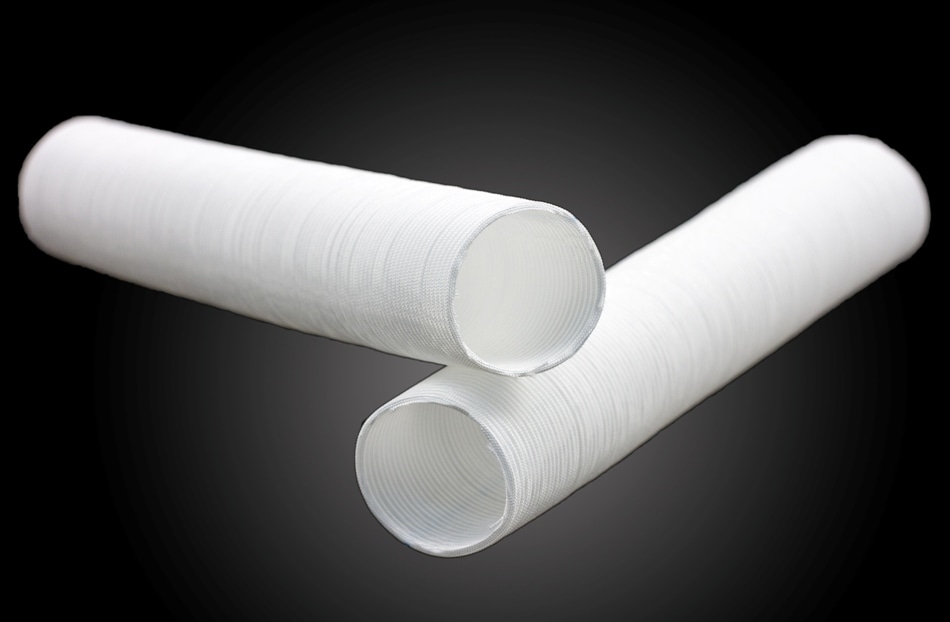As medical technology increases, so too does the availability of options for different biomedical applications. With so many different characteristics available in woven biomedical textiles, choosing the right, reliable textile is essential for mitigating risk and ensuring successful procedures and applications.
 A biomedical woven tube. Bally Ribbon Mills biomedical textiles can be woven into straight, tapered, flared, or bifurcated structures.
A biomedical woven tube. Bally Ribbon Mills biomedical textiles can be woven into straight, tapered, flared, or bifurcated structures.
Woven Biotextile Properties
Weaving biomedical textile structures, such as straight, tapered, flared, and bifurcated vascular grafts, is an art requiring precision and unwavering attention to detail. The structures are made by weaving, knitting, and braiding, in which two sets of fibers or yarns are tightly interlaced. High quality woven textile structures for biomedical applications possess dimensional stability, high suture retention strength, high burst strength, and controlled permeability and porosity. In addition, they embody high tensile strength in both directions; low elongation, unlike knitting products; and high abrasion and friction resistance.
Many of these biomedical textile structure characteristics are prerequisites for use in implanted applications. Without high abrasion and friction resistance, for example, wear from internal movement could lead to malfunction and failure. Other characteristics particularly benefit specific applications, such as high burst strength for vascular implants required to hold up to blood pressure. Dimensional stability enables structures to retain their shapes for longer periods of time, and low elongation in a woven structure ensures the device serves its intended purpose. High tensile strength in both directions protects devices against defects from wear. Controlled permeability and porosity are especially important in a biotextile because it can withstand consistent blood flow. Finally, high suture retention strength enables the device to remain properly in place during implantation and recovery.
The advantages of biotextiles prove important in mitigating risk, so many device designers choose biotextiles over non-textile options for biomedical applications. Materials such as elastomer tubes, for example, do not possess the same beneficial characteristics.
Selecting the Right Biomedical Fiber
Medical technology has evolved substantially in recent years. With so many material options available, appropriately selecting a biomedical fiber for a given application depends on the performance required of the biomedical device in question.
For example, PET (polyester) fiber has been used in implantable devices for many years, as it is biocompatible with the body. In contrast, PGA (polyglycolic acid) fiber is not used in long-lasting implantable devices because the fiber is designed to dissolve over time. As another example, the Nitinol wire, a metal wire that has a “memory,” is used in applications requiring the wire to return to its original shape. Sometimes, this wire is used in conjunction with polyester fiber.
Fibers are either absorbable or non-absorbable, an important distinction for almost any application. Non-absorbable fibers include polyethylene terephthalate (PET), expanded PET (ePET), polypropylene, high-modulus polyethylene fibers (Spectra®, Dyneema®), polytetrafluoroethylene (PTFE), expanded PTFE, polyurethane, and metallic wires. Absorbable fibers include polyglycolic acid (PGA), polylactic acid (PLA), and polylactic glycolic acid (PLGA). Hybrid fibers are made when non-absorbable and absorbable fibers are woven together. With decades of experience in biotextile weaving, Bally Ribbon Mills has the capability to use monofilament, multifilaments, hybrid fibers, and metallic wires in their products.
It is also important to take into account the risks associated with a particular medical device when choosing the appropriate biomedical fiber for the application, in order to mitigate risk as much as possible. The FDA classifies medical devices as Class I, Class II, and Class III by the risks to the patient and/or the user and by the intended use of the device. Those with high risk, classified as Class III, usually sustain or support life, are implanted, or present a potential unreasonable risk of illness or injury. Examples include implantable pace makers, penile grafts, stents, and vascular grafts. Given the high stakes for those involved, using the fiber best suited for the application is crucial.
The Shuttle Loom Advantage
Designing and prototyping with biotextiles is a complex process requiring advanced technology. This process necessitates extensive expertise, skills, and knowledge of textile fibers, textile machineries, and weave designs.
Shuttle loom technology can produce perfect tubes, bifurcated tubes, flared tubes, and tapered tubes as well as desired shapes. Other weaving technologies, such as needle looms and rapier looms, cannot produce a perfect tube or other required shapes without fringes or double picks. Medical devices should not have any defects, such as missing picks, floats, or broken ends, that could affect performance. In addition, the dimensions of the device should be perfectly precise. Only automated shuttle looms can eliminate these defects. For these reasons, Bally Ribbon Mills exclusively uses shuttle loom technology to weave biomedical textiles in order to ensure the highest quality products.
At Bally Ribbon Mills, all medical products are manufactured in a Class 8 certified clean room, including all aspects of shuttle loom weaving. All Class III medical devices must be manufactured in a tightly-controlled clean room environment due to risks associated with such devices. The company’s quality control professionals also monitor operations and conduct final inspections inside the clean room. With this manufacturing environment and rigorous quality control processes, BRM is ISO 13485 certified for designing and manufacturing textile components for medical devices.
The Future of Biotextiles
The future of weaving for biomedical applications is trending toward increasingly advanced shuttle loom technology with more automated features. New advancements include the incorporation of electronic components and jacquard capabilities (a system of weaving that utilizes a highly versatile pattern mechanism, enabling the production of large, intricate designs and shapes). Looking to the future, Bally Ribbon Mills recently updated its biomedical weaving capabilities with an automated shuttle loom with multiple shuttles. Increasing automation will produce the highest quality of biotextiles, ensuring biomedical application needs are met with the most cutting-edge materials for years to come.